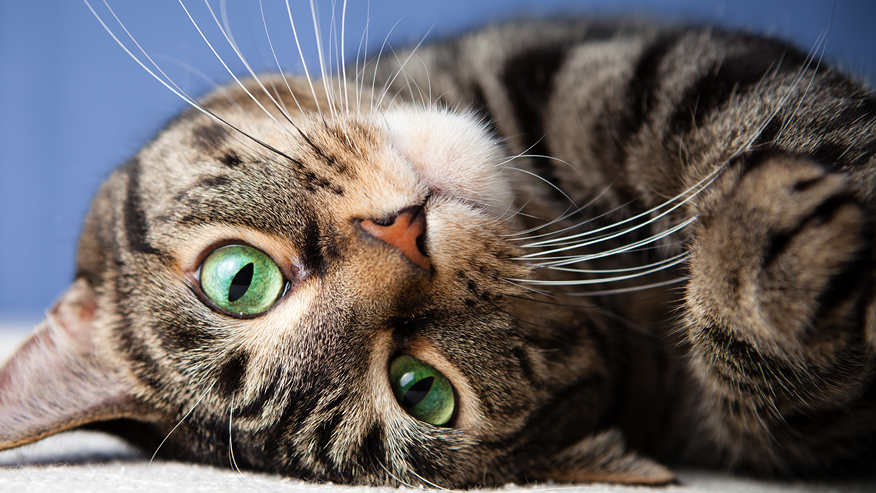Feline Vaccinations
Vaccinations are to help protect your pet from a number of potentially serious and even fatal diseases, such as Rabies. Not only that, vaccinations cost considerably less than the treatments available for the diseases pets are normally vaccinated against. Every pet should be vaccinated – even indoor dogs and cats can be exposed.
Feline Respiratory Disease
Feline rhinotracheitis (FVR) and feline calicivirus (FCV) are the two main causes of upper respiratory tract infections in cats. Although cats of any age can be infected, the young appear to be at greater risk. Clinical signs of infection include sneezing, nasal discharge and discharge from the eyes. Some cats with FVR cough, and some develop a severe eye condition called ulcerative keratitis. Cats with FCV can develop ulcers in the mouth, pneumonia, diarrhea and joint disease. Although most cats recover within 2 to 4 weeks, it is quite common for cats to become chronic carriers of these viruses, putting other cats at risk. Because these viruses are common in many areas, vaccination is highly recommended.
Chlamydia psittici is a parasite that is thought to be responsible for some upper respiratory tract infections in cats. It can lead to a severe form of lung disease if left untreated. Chlamydia more commonly causes a chronic conjunctivitis in cats. Outbreaks of Chlamydia are common when cats are housed together. Most veterinarians consider this an optional vaccination depending on your cat’s risk of exposure.
Feline bordetella is similar to canine bordetella and can result in signs of upper respiratory tract disease in cats. It can also cause a cat to cough. Vaccination is considered optional.
Feline Panleukopenia
Feline panleukopenia is a hardy virus, able to survive up to a year in the environment. Clinical signs include fever, loss of appetite, vomiting and diarrhea. It most often occurs in unvaccinated 3 to 5 month old kittens. If the virus attacks an unborn fetus, it may cause early death or cerebellar hypoplasia (“spastic kitten”). Most older cats exposed to this virus do not show clinical signs. An infected cat may be infertile. A cat may also abort her litter if infected during pregnancy.
This virus is spread via contact with an infected kitten or by contaminated premises, food or water bowls. Most veterinarians consider vaccination for panleukopenia mandatory. Thanks to vaccination, this disease is now uncommon.
Rabies
Rabies is a viral disease that attacks the central nervous system of all warm blooded animals, including humans. Rabies is transmitted by saliva, which is usually transferred by a bite from an infected animal. The virus can also be transmitted via air (bat caves) and tissue (corneal transplants). The disease is frequently found in wild animals such as skunks, foxes, raccoons and bats.
Once infected, the disease is fatal. Prior to death, clinical signs may include a change in behaviour (e.g. increased aggressiveness or increased shyness), dilation of the pupils, excess salivation, snapping at the air, a shifting gait, and facial twitching.
As the virus can be transmitted to humans, no stray dog, cat or any wild animal should ever be approached. Wild animals, including raccoons, should never be kept as pets. The family pet should be kept on its own property or be leashed when off its property. To help prevent raccoon rabies, it is recommended that you cap chimneys, close up any holes in attics or outbuildings, and make sure that stored garbage does not act as a food source.
Vaccination is important in safeguarding your cat from infection with this virus. Some veterinarians recommend vaccinating every year, while others recommend a three-year vaccine. Talk to your veterinarian about the degree of risk for Rabies in your area, and about which vaccination protocol will provide your pet with the protection it requires.
Feline Leukemia Virus (FeLV)
Feline leukemia virus is capable of causing a number of diseases in cats. Lymphoma (lymphosarcoma) is the most common form of cancer caused by this virus. Although a number of forms of this cancer are possible, the most common ones involve the intestines or the chest. Clinical signs may include vomiting, diarrhea and weight loss (if the intestines are involved) or breathing difficulties (if the chest is involved). Any organ in the body can be affected.
Feline leukemia virus can also cause anemia, and can make a cat more susceptible to other viral and bacterial diseases. Any cat with a history of fever of undetermined origin, or an illness that comes and goes, should be tested for this virus.
The incidence of FeLV is highest in multi-cat households (lots of contact between cats) as the virus is spread via saliva and other body secretions (tears, blood, urine). Cats that mutually groom, share food and water bowls, litter pans, etc. are at higher risk. “Social” outdoor cats that meet and greet other cats, mutually groom or fight are also at risk.
A blood test is available to test for infection with this virus. Not all “positive” cats will become sick with the disease. Some cats are able to mount a good immune response and overcome the virus. Others are not and will develop FeLV associated disease or cancer, usually within 3 years.
If your cat tests positive for FeLV, it is important that your cat not roam free, as the virus is highly contagious. Such a cat is prone to developing serious complications from other viral or bacterial diseases, so any time the cat does not appear well (has a fever, doesn’t eat), you should see your veterinarian.
If a cat in your household dies of Feline Leukemia, the household should be thoroughly disinfected (especially the litter boxes, food and water bowls, bedding, toys). It is best to wait at least one month before introducing another cat to the household.
Many cats are at high risk for exposure to this virus. If you own more than one cat, if you have a cat that roams outdoors or is very sociable and likely to contact other cats, or if the background of your cat is unknown (adopted from the shelter, etc.) speak to your veterinarian about testing your cat’s blood for this virus. Your veterinarian can help you assess the need for vaccinating your cat(s) against FeLV.
Feline Infectious Peritonitis (FIP)
Feline infectious peritonitis is a Coronavirus. The disease is not common. It occurs most often in cats that are:
- 6 months to 2 years of age and in those that are older than 11 years of age
- in multi-cat households (especially catteries)
- in cats that are infected with Feline Leukemia or Feline Immunodeficiency Viruses
- in cats whose immune system is compromised
The virus is spread by contact with an infected cat (feces, saliva, blood, urine). Prolonged exposure to an infected cat is usually necessary for transmittal of the disease.
Clinical signs of FIP take time to develop. There are two forms of the disease. One, the wet form, results in fluid build-up in the abdomen or chest. The other, the dry form, results in granulomas (lumps of inflammatory tissue) in multiple organs of the body. Infected cats will often exhibit weight loss, fever and loss of appetite.
Although treatment is available to make infected cats more comfortable, the disease is inevitably fatal. An intranasal vaccine is available. Please speak to your veterinarian about your cat’s risk of exposure and the need for a vaccination.
FIV
FIV is capable of causing a number of diseases in cats in a similar manner to FeLeuk virus. It is most common in male and free-roaming cats. Transmission is usually by a bite wound.




